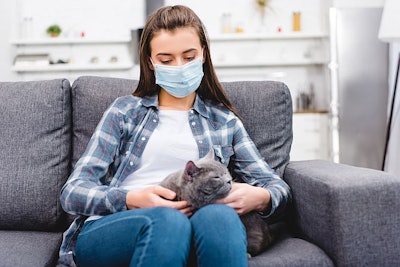
The COVID-19 pandemic’s effect on the pet food industry has been wide ranging and hard to fully comprehend. Focusing on four main areas allows one to better understand it, Jared Koerten, head of pet care at Euromonitor International, said in a recorded webinar presented by Euromonitor and Interzoo about the COVID-19 pandemic’s effects on the pet supplies industry.
“At the end of the day, what are the four strategic areas that you can take away and say I need to innovate here, I need to think here I need to strategize in these?” he said.
-
Macroenvironment
Along with illness and death, an unprecedented global economic drop accompanied the pandemic as whole nations locked down. This macroeconomic situation overarches everything else in the pet food industry. The virus follows its own biological imperatives, regardless of politics and belief. The pandemic has spread faster in some countries than others depending on numerous public health variables. The number and variety of those variables combine with innumerable influences on the economy to make forecasting difficult.
“We are heading into or currently into a very severe global recession, the macroeconomic impact will be severe and enforced lockdowns like we've never seen before,” he said. “Things could become significantly more pessimistic quite quickly.”
Koerten presented four potential courses for global real gross domestic product (GDP) growth. The mildest, baseline projection assumed a global infection rate between one and ten percent, resulting in a decline of one to four percent in the global real GDP, as the pandemic continued for up to three quarters. He rated the probability of this scenario at 38-48%. On the other end of the spectrum, the most pessimistic outlook warned of a global GDP drop of 11.5-8% if the infection rate worldwide swells to 20-50% over three to seven quarters.
-
Supply chain
“The very task of a manufacturer to get products to market during a global pandemic is anything but easy,” Koerten said. “It is a significant challenge.”
Supply chain pressures go beyond concerns over workers’ health. As the disease spreads through meat processing plants and pet food facilities, there can be regional disruptions in production and supply while plants close for sanitation. These problems are compounded by larger scale disruptions in international commerce as borders close and movement controls limit travel and shipping.
-
Channel
“Probably one of the most significant developments we've seen in the market is where consumers are shopping, and where consumers are buying,” he said.
Shipping also plays a major part of the third major factor influencing pet supplies. Pet owners have shifted significantly towards e-commerce during the pandemic. The surge caused delays and out-of-stock problems in some cases, Koerten said. However, overall, online sales of pet food and supplies have grown dramatically as pet owners also change their work routines. The pet specialty channel on the other hand has suffered as trips out fall.
-
Consumer
“We're dealing with a very challenging time of social isolationism of social distancing is a new era for pet ownership pet bonding and big changes in pet ownership that could have significant implications on the long term evolution of the global pet care market,” he said.
Pet ownership in the United States increased during the early stages of the pandemic, as people looked for companions to keep themselves and their families’ company. The increased amount of time people then spent with their pets likely increased their pet-human bonds, as pet owners continue to look for ways to please their pandemic pals with pet food, treats and other products.
















